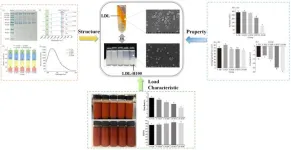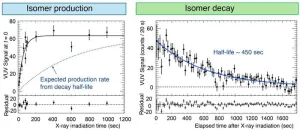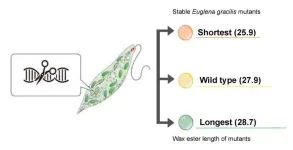(Press-News.org) COLUMBUS, Ohio – Though a founding concept of ecology suggests that the physical environment determines where organisms can survive, modern scientists have suspected there is more to the story of how microbial communities form in the soil.
In a new study, researchers have determined through both statistical analysis and in experiments that soil pH is a driver of microbial community composition – but that the need to address toxicity released during nitrogen cycling ultimately shapes the final microbial community.
“The physical environment is affecting the nature of microbial interactions, and that affects the assembly of the community,” said co-lead author Karna Gowda, assistant professor of microbiology at The Ohio State University. “People in the field understood these two things must be important at some level, but there wasn’t a lot of evidence for it. We’re adding some specificity and mechanisms to this idea.”
The work helps clarify the microbial underpinnings of global nitrogen cycling and may provide a new way to think about emissions of nitrous oxide, a potent greenhouse gas, Gowda said.
The research was published recently in Nature Microbiology.
Microbes keep soil healthy and productive by recycling nutrients, and are particularly important for converting nitrogen into forms that plants can use. Underground organisms living in the same environment are also highly interconnected, preying on each other, participating in chemical exchanges and providing community benefits.
For this work, Gowda and colleagues used a dataset from a worldwide collection of topsoil samples, sequencing the genomes of microbes present in the samples and analyzing important characteristics of the soil – such as nitrogen and carbon content and pH, a measure of soil’s acidity.
“We wanted to look at trends that were widespread and that would manifest around the planet across very different environments,” Gowda said.
With billions of bacteria present in a sample of soil, the researchers relied on the genetic makeup of microbial communities to determine their functional roles.
The team zeroed in on genes that identified which bacteria were involved in denitrification – converting nitrogen compounds from bioavailable forms into nitrous oxide and dinitrogen gas that’s released in the atmosphere. A bioinformatics analysis showed that soil pH was the most important environmental factor associated with the abundance of these organisms.
To test the statistical finding, the researchers conducted lab enrichment experiments, running a natural microbial community through different conditions of growth.
During denitrification, specific enzymes have roles in the conversion of nitrate into various nitrogen-containing compounds. One of these forms, nitrite, is more toxic in acidic soil (low pH) than it is under neutral conditions with higher pH.
The experiments showed that strains with enzymes called Nar, linked to creating toxic nitrite, and strains with enzymes called Nap, linked to consuming nitrite, fluctuated based on the acidity of the soil.
“We found more of Nar at low pH and less of Nap, and vice versa as the soil pH moved toward neutral,” Gowda said. “So we see two different types of organisms prevalent at acidic versus neutral pH, but we also find that that’s actually not explaining what’s going on. It’s not just the environment that’s determining who’s there – it’s actually the environment plus interactions between more organisms in the community.
“This means that pH is affecting the interaction between organisms in the community in a more or less consistent way – it’s always about the toxicity of nitrite. And this highlights how different bacteria work together to thrive in varying soil pH levels.”
That finding was novel and important, Gowda said. Bacteria and other microorganisms are known to be driven by a will to survive, but they also rely on each other to stay safe – and that cooperation has implications for environmental health, the research suggests.
“While individual fitness effects clearly play a role in defining patterns in many contexts, interactions are likely essential to explaining patterns in a variety of other contexts,” the authors wrote.
Understanding how interactions and the environment affect nitrous oxide emissions could provide new insights into reducing this potent greenhouse gas, Gowda said: Denitrifying bacteria are key sources and sinks of nitrous oxide in agricultural soils. While past studies have focused on the behavior of these nitrous oxide-emitting organisms in different pH conditions, considering their ecological interactions may offer new strategies to lower emissions.
This work was supported by the National Science Foundation, the University of Chicago, the National Institute of General Medical Sciences, a James S. McDonnell Foundation Postdoctoral Fellowship Award, and a Fannie and John Hertz Fellowship Award.
Co-authors include Seppe Kuehn, Kyle Crocker, Kiseok Keith Lee, Milena Chakraverti-Wuerthwein and Zeqian Li of the University of Chicago; Mikhail Tikhonov of Washington University in St. Louis; and Madhav Mani of Northwestern University.
#
Contact: Karna Gowda, Gowda.51@osu.edu
Written by Emily Caldwell, Caldwell.151@osu.edu; 614-292-8152
END
Media Contact:
John Dudley
(814) 490-3290 (cell)
jjdudley@usf.edu
KEY TAKEAWAYS:
A species of single-celled organisms called foraminifera (forams) is increasing in warm, alkaline waters of the eastern Mediterranean, building beaches with their calcium carbonate skeletons.
In regions like Turke, forams are creating sandy shorelines where there used to be rocky terrain, benefiting tourism.
Forams thrive in warm waters with high CO2, suggesting they might continue growing as climate change accelerates.
This species of foram, once native to the Mediterranean, is returning as human activities make ...
In a world where organizing a simple meeting can feel like herding cats, new research from Case Western Reserve University reveals just how challenging finding a suitable meeting time becomes as the number of participants grows.
The study, published in the European Physical Journal B, dives into the mathematical complexities of this common task, offering new insights into why scheduling often feels so impossible.
“If you like to think the worst about people, then this study might be for you,” quipped researcher Harsh Mathur, ...
EMBARGOED FOR RELEASE UNTIL 9 A.M. ET ON SEPT. 13, 2024
TAMPA, Fla. (Sept. 10, 2024) – Employees often feel pressure to work while sick, leading to lost productivity, deviant behaviors such as theft and mistreatment of coworkers and intent to leave the organization, according to new research led by University of South Florida Assistant Professor of Psychology Claire Smith. The cost of such behavior, known as “presenteeism,” can be staggering – as much as $150 billion annually, according to Harvard Business Review.
The findings will be ...
Paprika oleoresin (PO), extracted from chili peppers, is renowned for its vibrant color and beneficial health properties, such as antioxidant and anti-inflammatory effects. However, its lipophilic nature and sensitivity to factors like oxygen, heat, and light restrict its use in water-based foods. While previous approaches, including emulsions and liposomes, have aimed to improve PO’s stability, the results have been limited. These persistent challenges underscore the need for new stabilization methods for PO.
The study (DOI: 10.26599/FSAP.2024.9240064), led by scientists from Chengdu University and Huazhong Agricultural ...
Atlanta, Georgia - In the wake of mounting evidence for the efficacy of psychedelic-assisted therapies, the U.S. Food and Drug Administration (FDA) is considering approving psilocybin, the active ingredient in “magic mushrooms,” for treating depression in the near future. As this watershed moment approaches, a critical question arises: Just how many people might stand to benefit from this promising but still unproven therapy?
Shedding light on this high-stakes inquiry, a first-of-its-kind peer-reviewed study led by researchers at Emory University, the University of Wisconsin-Madison and ...
Scientists use atomic clocks to measure ‘second,’ the smallest standard unit of time, with great precision. These clocks use natural oscillations of electrons in atoms, similar to how pendulums work in old grandfather clocks. The quest for an even more precise timekeeper led to the discovery of nuclear clocks, which use the transitions of atomic nuclei instead of electrons to keep time.
A rising contender for the development of ultra-precise nuclear optical clocks is the nuclear first-excited state of 229Th isotope. Its long half-life of 103 seconds and low excitation energy of a few electron ...
In a new study by the Potsdam Institute for Climate Impact Research (PIK), researchers analysed how erratic weather events, increasingly intensified by global warming, affect global production and consumption across different income groups. The results confirm previous studies that the poorest people worldwide bear the greatest economic risks from climate change. Surprisingly, the risk for the wealthy is growing the fastest. Economies in transition like Brazil or China are also highly vulnerable to severe impacts and negative trade ...
News about biofuels sometimes mentions used cooking oil as a feedstock, but if these substances contain animal fat, they can solidify in colder temperatures. This happens because, chemically, the fatty acids of these and many other saturated fats have long carbon chains with single bonds. Enter the euglena. An Osaka Metropolitan University team has found a way to have one species of this microalgae produce wax esters with shorter carbon chains than usual.
Using CRISPR/Cas9 to edit the genome of Euglena gracilis, Dr. Masami Nakazawa and her team at the Graduate School of Agriculture’s ...
A team led by Dr. Hyeon-Gyun Im and Dr. Dong Jun Kang from the Insulation Materials Research Center of Korea Electrotechnology Research Institute (KERI), in collaboration with Dr. Jung-keun Yoo from KIST and Professor Jong-soon Kim from Sungkyunkwan University, have developed a technology that enhances the performance of binders—often the 'unsung heroes' in the field of secondary batteries—while using environmentally friendly materials. This technology has been published in a prestigious international ...
CHICAGO (Sept 13, 2024)—Menopause is a natural life transition occurring when many women are at the “top of their game.” Unsupported menopause symptoms drive up employer healthcare costs and cause roughly $1.8 billion in missed workdays. To help employers retain these valued workers and build cultures of well-being, The Menopause Society launched Making Menopause Work™ based on new science-based Consensus Recommendations. The Recommendations are published online in Menopause, the journal of The Menopause ...





